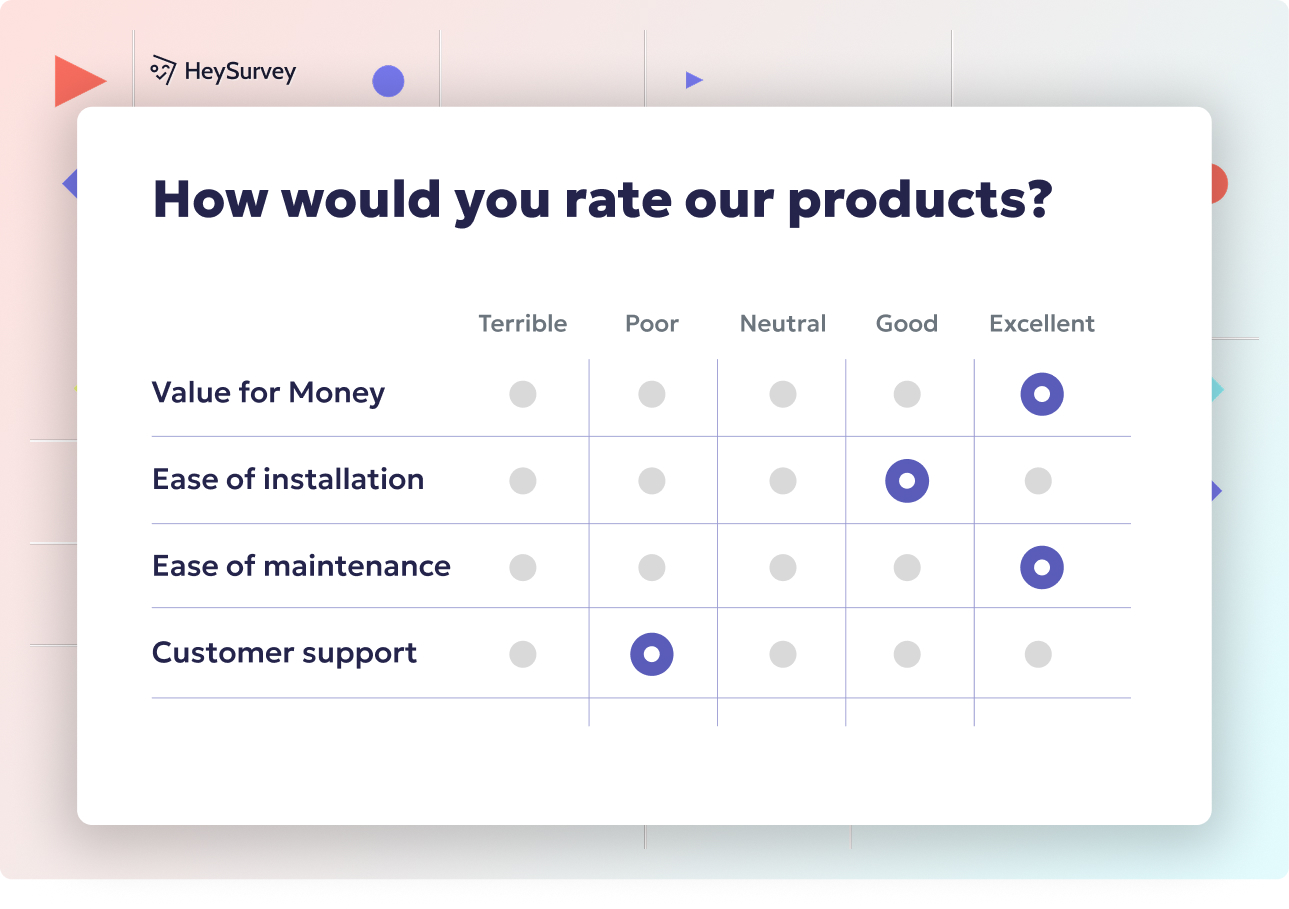31 School Climate Survey Questions to Measure School Culture
Explore 30 essential school climate survey questions with samples for students, staff, parents, and more to assess safety, belonging, and culture.
School climate survey questions play an essential role in shaping positive educational experiences for everyone involved in the school community. The term “school climate” covers everything from safety and relationships to the quality of teaching, learning, and even how welcoming the physical environment feels. K-12 leaders, education researchers, and ed-tech vendors depend on robust climate data to drive improvement plans, secure funding, meet compliance requirements, and boost social-emotional learning initiatives. Whether you’re collecting annual comprehensive insights or quarterly pulse check-ins, surveying students, staff, and parents is critical to measuring school culture and creating a roadmap for meaningful change.
Student School Climate Survey
Focus: Perceptions of Safety, Engagement, Belonging & Respect
A student climate survey zooms in on how students perceive their daily experience at school. This includes whether they feel safe, respected, and engaged, and if they really have a sense of belonging. These perceptions are often the earliest signs of future student outcomes, for better or worse.
If a student feels valued and secure, chances are they’ll be more involved both academically and socially. Hidden issues like low-level bullying or feeling left out don’t always show up in hard data like attendance or test scores; surveys uncover these subtle realities.
Students’ voices are powerful—they offer a raw, unfiltered look at school life from the inside out. Plus, benchmarking student perception of school climate year-over-year helps leaders see which tweaks made a difference (and which flopped).
Why & When to Use
- Gauge student voice and ensure students feel heard
- Early warning for student disengagement or social-emotional red flags
- Benchmark improvements or regressions in climate year-over-year
- Ideal for annual comprehensive reviews or quick quarterly “pulse checks”
- Useful before new initiatives or following significant events
Sample Questions
- I feel safe in hallways and common areas.
- Teachers treat all students with respect.
- I feel like I belong at this school.
- I know at least one adult at school I can talk to if I need help.
- I enjoy participating in class or school activities.
A study analyzing data from 95,545 students found that those experiencing severe bullying were over 11 times more likely to suffer from emotional and behavioral problems. (arxiv.org)

Creating a school climate survey with HeySurvey is a breeze—even if you’re new to the platform! Follow these 3 easy steps to build your survey quickly and start collecting valuable feedback:
Step 1: Create a New Survey
- Open HeySurvey and select Create New Survey.
- Choose to start from scratch with an empty sheet, or pick a pre-built school climate survey template (highly recommended to save time).
- Give your survey a clear internal name—something like “School Climate Survey 2024” to keep things organized.
Step 2: Add Questions
- Use the Add Question button to insert questions, picking from types like Choice, Scale, or Text depending on your needs.
- Customize each question with clear, concise wording to match your focus area (students, staff, parents, etc.).
- Mark important questions as required to ensure you get vital responses.
- Don’t forget: you can add images or descriptions to help clarify questions!
Step 3: Publish Survey
- Click Preview to test your survey and make sure everything looks perfect on desktop and mobile.
- When ready, hit Publish to generate a shareable link you can email or embed on your school website.
- Note: Publishing requires creating a free HeySurvey account, which also lets you access collected responses.
Bonus Step: Apply Branding
- Access the Designer Sidebar to upload your school logo and adjust colors and fonts so the survey matches your school’s style beautifully.
Bonus Step: Define Settings
- Set start/end dates, response limits, and even a thank-you redirect URL via the Settings Panel so you control when and how the survey runs.
Bonus Step: Skip Into Branches
- Use branching logic to tailor questions based on previous answers, making sure respondents see only relevant items and your data is cleaner.
Ready to get started? Just hit the button below to open a pre-built School Climate Survey Template and customize it for your school!
Teacher & Staff School Climate Survey
Focus: Professional Support, Leadership Trust, Wellbeing & Discipline Consistency
A teacher and staff climate survey shines a light on the internal ecosystem that drives school success. When educators feel supported, trusted, and included in decisions, both morale and retention rates go up. The survey explores whether staff believe leadership listens and acts fairly, plus the consistency of discipline processes—no one likes surprises when it comes to the rules!
Professional growth, emotional health, and workload balance also come into play. Spotting burnout, confusion, or low trust early lets leaders adapt, so teachers can focus on inspiring students rather than dreading the next staff meeting.
Why & When to Use
- Diagnose staff morale and engagement
- Identify retention risks before they spiral
- Pinpoint professional development (PD) needs for targeted support
- Use mid-year for quick pivots, end-of-year for big-picture planning
- Share back results to boost transparency and school-wide trust
Sample Questions
- I feel supported by school leadership in carrying out my responsibilities.
- The professional development opportunities offered meet my needs.
- Discipline policies are enforced consistently across the school.
- Staff members are treated with respect, regardless of their role.
- I have access to resources that support my wellbeing at work.
Positive school climate, effective leadership, and school safety are associated with lower teacher turnover intentions and behaviors. (brookings.edu)
Parent/Guardian School Climate Survey
Focus: Communication Quality, School–Home Partnership & Inclusivity
A strong parent school climate survey uncovers how well families believe their school fosters communication and partnership. Parents notice things staff may miss—like emails lost in translation, confusing registration processes, or whether families from all backgrounds feel genuinely welcome.
A sense of family engagement and transparent communication is key for meeting Title I mandates and building trust. This survey reveals hidden gaps in school–home partnership and surfaces the often-overlooked parent perspective.
Why & When to Use
- Meet family engagement and Title I mandates
- Reveal communication gaps and inequitable engagement
- Gather feedback for improvement during conferences or enrollment
- Encourage participation by emphasizing value and anonymity
- Follow up on survey insights with real action (and let families know it)
Sample Questions
- The school communicates important information in a way I can understand.
- I feel welcomed and included when I visit the school or attend events.
- The school regularly seeks my input about policies and activities.
- My child’s culture, home language, or background is respected by the school.
- I am satisfied with how quickly staff respond to my concerns or questions.
Classroom-Level Climate Pulse Survey
Focus: Micro-Environment Within Individual Classes
Sometimes the real action happens in the classroom, not the cafeteria. A classroom climate pulse survey captures the specific dynamics at play between a particular group of students and their teacher. These surveys are short, sweet, and frequent—think weekly, biweekly, or monthly—so you can keep your finger on the pulse and make agile adjustments.
Teachers can identify which strategies foster connection, which kids may need a little extra TLC, and when the vibe in the room starts to dip. When used right, these pulse surveys enable real-time SEL check-ins and rapid response to small issues before they become big headaches.
Why & When to Use
- Weekly, biweekly, or monthly for sustained climate insights
- Agile instruction adjustment in response to quick shifts
- Early SEL intervention or routine emotional check-ins
- Data to foster teacher-student trust and engagement
- Can be anonymous or named, depending on the purpose and age group
Sample Questions
- I feel comfortable asking questions in this class.
- We take time to appreciate everyone’s ideas and opinions.
- My teacher supports me when I try something difficult.
- Our classroom feels respectful, even when we disagree.
- If I’m having a hard day, I feel like someone in the class would notice.
Regular classroom climate surveys can enhance student engagement and learning by providing real-time feedback for teachers to adjust their strategies. (panoramaed.com)
Safety & Bullying-Focused Climate Survey
Focus: Physical/Emotional Safety, Bullying Prevalence & Reporting Confidence
Every student deserves to feel safe at school, plain and simple. A school safety survey hones in on whether students, staff, and families perceive the school as safe and whether bullying—of any kind—is an issue. This isn’t just about detecting overt danger; it’s also about emotional security and confidence in the process for reporting incidents.
These surveys are crucial for anti-bullying compliance. They function as both proactive checkups and reactive diagnostics after incidents. The data collected informs policies, staff training, and targeted interventions to create a zero-tolerance environment for harassment.
Why & When to Use
- Required by many state anti-bullying laws or wellness policies
- Diagnose school climate post-incident or upon concern
- Annual or semi-annual to track progress and prevention measures
- Communicate clearly about anonymous, safe reporting
- Use findings to design anti-bullying campaigns and restorative practices
Sample Questions
- I feel safe at school every day.
- Bullying is dealt with quickly when adults are told about it.
- I know how to report bullying if I see or experience it.
- I trust that my privacy will be respected if I report an incident.
- I have seen or experienced bullying at school in the last month.
Diversity, Equity & Inclusion (DEI) Climate Survey
Focus: Fairness in Discipline, Cultural Responsiveness & Representation
Building an inclusive school climate starts with asking the right questions. A diversity, equity, and inclusion (DEI) climate survey looks beyond surface-level representation to measure how students and staff experience fairness, belonging, and respect. Do all races, identities, and experiences feel included? Is discipline administered equitably?
These surveys are central to equity audits, which support funding proposals, grant applications, and public reporting. They also help schools track the impact of new DEI policies, programs, or leadership changes.
Why & When to Use
- Annual surveys for continuous progress tracking
- Use after launching new equity or inclusion programs
- Collect feedback following changes to discipline or curriculum
- Provide data for grant applications and compliance
- Use findings to inform staff PD and student voice groups
Sample Questions
- Discipline is applied fairly to students from all backgrounds.
- I see people who look like me represented in school leadership and teaching staff.
- The school celebrates and teaches about different cultures and traditions.
- Teachers understand the backgrounds and communities of their students.
- All students are given the same opportunities regardless of who they are.
Remote & Hybrid Learning Climate Survey
Focus: Engagement, Access & Sense of Connection in Virtual Settings
When learning shifts online (temporarily or long-term), it’s time for the online school climate survey. How well are students, staff, and families adapting to digital platforms? Is everyone able to log in, connect, participate, and feel seen—even from behind a screen?
A virtual classroom survey measures tech access, comfort, and connection—prime ingredients for effective remote or hybrid learning. These insights help schools fine-tune tech supports, boost SEL efforts, and bridge equity gaps exposed by remote learning.
Why & When to Use
- During remote or hybrid learning periods for real-time feedback
- Post-remote transitions to inform ongoing tech integration
- Identify equity gaps in device/internet access and support
- Guide schoolwide SEL strategy for remote and hybrid students
- Build a community despite physical distance
Sample Questions
- I have reliable access to the internet and technology needed for online learning.
- I feel connected to my teachers and classmates, even in virtual settings.
- The school offers help when I have technology issues.
- I receive support for my emotional wellbeing while learning from home.
- Online assignments and expectations are clear and easy to understand.
Best Practices: Dos and Don’ts for Crafting School Climate Survey Questions
School climate survey best practices ensure that your instrument is fair, effective, and usable. The best questions align with trusted research-backed frameworks, like those from NCES or CASEL, and match your unique school context. Keep language simple, so everyone understands, and always protect anonymity.
Dos
- Use frameworks from NCES, CASEL, or similar research to shape your questions
- Write in plain, accessible language at an appropriate reading level
- Guarantee anonymity to encourage honest responses
- Pilot test with a small group before widespread deployment
- Offer multiple response scales (like 5-point Likert) and add comment boxes at the end
- Keep surveys manageable in length—better many short than one marathon
- Translate surveys into home languages spoken by your community
Don’ts
- Avoid double-barreled questions (e.g., “I feel safe and supported at school”)
- Steer clear of leading language (“How great was your teacher today?”)
- Don’t use overly long or overly complex scales
- Don’t collect identifiable comments without disclaimers or consent
- Never skip a follow-up: data without action erodes trust fast
Creating impactful questions is only half the battle. Always follow up with clear action plans, share the results with your community, and keep the survey cycle going year after year. This is the surest way to measure school culture and build a climate where everyone thrives. For more guidance, check out resources on climate analytics and step-by-step action planning for school leaders.
A well-crafted climate survey isn’t just a compliance task—it’s the heartbeat of a positive, responsive school. Tune in to your community, and watch the climate brighten for students, staff, and families alike.
Related Culture Survey Surveys

29 Climate Survey Questions: Types, Uses & Winning Examples
Explore 25 expert climate survey questions across employee, school, DEI, safety & community surve...

28 Campus Climate Survey Questions for Effective Feedback
Discover campus climate survey questions with 25 insightful samples on DEI, safety, and well-bein...

29 Essential Bullying Survey Questions to Improve Safety
Explore 30+ effective bullying survey questions with sample queries across student, workplace, cy...
